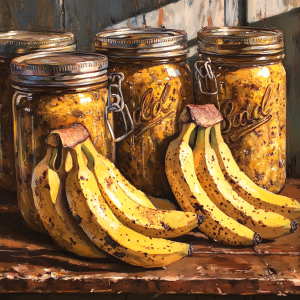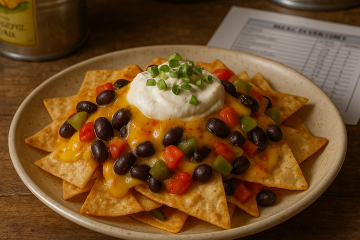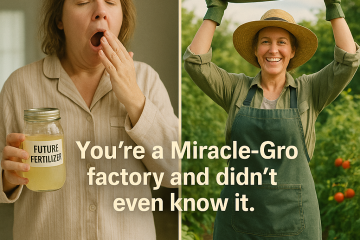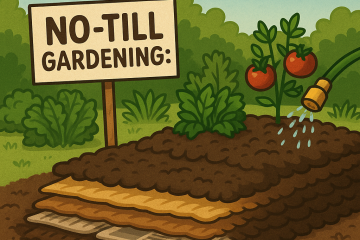
yes, you can can bananas
The other day a friend of mine gave me a tip that you can obtain an entire case of bananas from most Wal-Marts in the nation simply by contacting the Produce Manager and asking them to take their old bananas off of their hands. The standard cost is only $5! There are instances in which some of the Wal-Marts have elected to donate their used produce to Food Banks or other community help centers, but it’s certainly doable a lot of the time in many areas of the U.S. Regardless of how you feel about Wal-Mart, you can still call up the other grocery stores and ask them if you can take old produce off of their hands. Yup, there’s all kinds of FREE food for the taking among those who exercise some initiative.
Now, what would you want with a bunch of old produce from the grocery stores? Well you can can it, of course. *grin* And yes, this also applies to bananas.
My dear friend, Debbie C., first introduced me to canning bananas when she was on a crazy canning bananas binge. I love hearing from her because she’s always pushing herself to discover new ways to ensure independence in her kitchen. (Yup, now you know why I like her so much.) Anyway, I had never heard of canning bananas. So I checked with my always reliable resource, Jackie Clay of Backwoods Home Magazine and sure enough, she’s discussed this topic too. I also found other major food manufacturers addressing it as well. Cool! Whoda thunk it? I’ve just been stocking up on freeze-dried bananas and banana chips. Obviously, paying a few bucks for a case of bananas is a heck of a lot better deal than a #10 can from Augason Farms for banana chips. So I’m all in favor of embracing this method—especially since it can be done just with a water bath instead of pressure canning. (Water bath canning is almost as easy as “FoodSaver canning” in my opinion.)
How can you use canned bananas? Lots of great ways. Pancakes, banana syrup, cakes, muffins, bread, smoothie sweetener and flavors, and it also makes a delicious frozen treat if you’ve got access to that in a crisis scenario.
Anyway, here are the article including the instructions on canning bananas that Debbie has given me as well as what she’s observed over the years.
Canning Bananas by Debbie C.
With the revived interest in canning these days, grandma’s pressure cooker has been rescued from the cellar, mason jars that have been stored up in the attic for years have been uncovered, and old cookbooks that had been stuffed in the back of closets have been dusted off and read. People are rediscovering the possibilities of canning and realizing the worth of putting up foods that don’t require electricity to store. Everything from corn and beans to meats and stews are successfully being canned. There is one item that very few people realize is can-able. (I’m not quite certain that is a word, but it should be!) That item would be bananas!
I came into a windfall of bananas a few years ago and wondered what in the world I was going to do with them! I had recently bought half a cow and had that stuffed in my freezer, so I couldn’t fit any bananas in there. There are only so many bananas that a person can eat before they go bad and your kitchen is full of fruit flies; dehydrated bananas stick in my teeth; so, I decided to can them. Think about it, you can buy canned bananas in baby food, right? So why not?
Bananas are not commonly grown in the U.S. so it’s not likely that a person can just grow them in their backyard or their indoor aquaponics system. In a disaster scenario, bananas will be difficult to find but I happen to love bananas! I love banana bread, banana pancakes, banana smoothies, banana in my oatmeal, and in my yogurt—just to name a few ways I eat them. So, canning bananas just makes sense to me, and it’s extremely easy to do! Here are the steps that I use:
1. First mash your bananas. Bananas are a very dense food so it is necessary to mash them and make certain that they are heated through. I use a blender to mash mine, but a potato masher or a food processor would work as well. Just be certain that the bananas are well mashed and there are not many large clumps left.
2. Pour the mashed bananas into a large pot along with citric acid or lemon juice. I put 1 tablespoon of lemon juice or 1 teaspoon of citric acid per quart to prevent browning and to add acidity.
3. Heat the mixture on medium high heat and stir frequently. You’re going to want to heat them to the point just before the mixture starts to boil. (Since it’s a dense mixture, you’ll have some “popping” of the mixture. This is the time that you really want to be sure to stir the mixture so that you distribute the heat equally throughout the mix.
4. Pour the mixture into unquestionably clean, sterilized, hot jars. Fill the jars of choice leaving a half inch head on them from the top of the jar. Top them with clean, sterilized lids and screw the rings on to “fingertip tight”.
5. Water bathe quart jars for 15 minutes and pints for 10 minutes. (I prefer to use pints as that amount is more realistic for my other recipes in which I would use the bananas.)
I have had no problems using the canned bananas. The only issue that I have had is that the longer they are kept, some browning does occur at the top of the jar. I usually take off the really brown portion off of the top of the jar and discard it just like I would a brown spot on a banana. Also, when the jars have been stored for a couple of years, some separation does occur with liquid forming on the bottom of the jar. I simply stir the mixture together and use as normal.
Happy Canning!
Obviously, you can also dehydrate the excess produce that you get your hands on. I’ll be getting some peaches this week and some apples and pears next month. I LOVE, LOVE, LOVE my Pear Butter recipe. I can use it on toast, pancakes or in oatmeal but I can also use it as a base for delicious barbeque sauces and as a refreshing topping for ice cream or a creamy rice pudding. It’s also great for a Pear Bisque recipe I make. Heaven! It’s that much better when you consider that I make it in a slow cooker without ANY peeling, slicing or any other timely prep steps. All I do is pull off the stems and cut out any obvious bruised areas and Voila! Delicious! Here’s the Pear Butter recipe I use. I know you’ll enjoy it!
Kellene’s Pear Butter
Ingredients
- 9 red or green Bartlett pears with the stems and obvious brusing removed. (I cut them in half sometimes, but that’s it.)
- 1 cup pear cider (it’s a lot like the non-alcoholic apple cider but so much better. But in a pinch, I’ve used the powdered Apple Juice that I purchase in #10 cans from Augason Farms. You can use Apple Cider instead, but the Pear Cider is distinct in its taste and flavors.)
- 1/2 cup brown sugar
- 1/2 cup sugar
- 1/2 teaspoon ginger
- 1/2 teaspoon cardamom
- 1/2 teaspoon allspice
- 1/4 teaspoon mace
Directions: Place all ingredients in a slow cooker. (Yes, you could make this on the stove top, but why would you want to? Splattering, constantly babysitting it for many hours? AND when you use the slow heat like you get in the slow cooker, you get a different taste because when sugars are broken down slowly, they simply taste different, richer, in my opinion. Besides, with a slow cooker, your whole house will smell DEE-VINE!)
Cook on low for 10-12 hours. Uncover and cook on low for an additional 10-12 hours or until is roughly your desired thickness and most of the liquid has evaporated. Allow to cool completely then pour into the food processor and puree. Pour into clean glass jars. Refrigerate for up to 2 months OR can it for long-term preservation.
To can the Pear Butter, be sure you begin with clean, sterilized, hot jars and lids. Pour the Pear Butter mixture while it’s still hot into your chosen jars leaving ¼ to ½ inch from the top. Be sure to wipe any spilled pear butter of the top. Place the lids on and then tighten the ring around them to “fingertip tight”. Put them in the canner and keep them covered with at least 1 inch of water and boiling. Process/water bath the pint jars for 5 minutes and quart jars for 10 min. (For high altitude canning, refer to your manufacturer’s instructions.)



41 Comments
Jv · August 27, 2012 at 11:24 pm
Sounds yummy! But what about the seeds in the pears?
Kellene Bishop · August 28, 2012 at 6:21 am
They will be liquified which is great because there’s great nutrients inside.
Jo · August 28, 2012 at 1:00 am
I LOVE this! Jackie Clay is my go to guru as well, and has an amazing canning book – two now. I am going to try this, have never heard of canning bananas but it would be oh so handy! Thanks! I would imagine they could be frozen as they get too ripe to eat and then when there is enough, mash and can.
Rani · August 28, 2012 at 2:23 am
Wow! what great ideas! Had not considered canning bananas, but now it is on my list of things to do in the near future. Thank you for bringing this to our attention. Will also keep my eyes open for a good deal on pears.
Gwen · August 28, 2012 at 3:04 am
This is so cool! I just never even thought of canning bananas! Thank you so much for both recipes! By the way, where do you get pear cider? I have not seen it in the stores. Thanks again for a great post.
Stephanie · August 28, 2012 at 3:08 am
When my grandson was 10 we got together one weekend and made “banana butter”, it was an instant hit and eaten with peanut butter on a sandwich seemed like heaven to him. I had a lot of over ripe bananas and found the recipe on the internet I believe. Just the memory of him and I making it together was worth all the tea in china !
Rosemary · August 28, 2012 at 3:14 am
This may sound silly, but where do you get pear cider? I have not seen this in my grocery stores. Is there a company that carries it so I could request it be stocked or gotten by special order from a regular grocery chain? Rosemary
Kellene Bishop · August 28, 2012 at 4:48 am
Trader Joes has it.
Susie Worlton · August 28, 2012 at 3:46 am
I love the idea of canning bananas…do you alter the processing time for high altitude?…i mean really high…we live at 9200 feet…great stuff…
Kellene Bishop · August 28, 2012 at 4:48 am
yes, “according to manufacturer’s instructions.”
RavenSpeaks · August 28, 2012 at 4:36 am
How appropriate! I just bought a bunch of bananas and was going to dehydrate them but I think I will can them instead 😉 Thanks!!!!!
Carrie · August 28, 2012 at 2:06 pm
I love the idea of canning bananas! How long do the jars keep? Do they start to turn dark right away? Thank you for the pear butter recipe too. I’ve been looking for a good one.
Debbie Cleveland · August 28, 2012 at 8:02 pm
Carrie…I have a jar that is dated 1/10 and it’s still fine with only a bit of brown on the very top.
Virgil · August 30, 2012 at 4:27 pm
Ok, I tried the banana canning. Not sure if I did this right. When heating, the bananas had some browning (more of a medium dark tan) and became a thick paste. My measurements were correct, so I’m wondering if these results are what I’m looking for.
Kellene Bishop · August 30, 2012 at 10:44 pm
I’d add more citric acid then.
SBrown · September 5, 2013 at 4:37 pm
I added 3/4 cup apple juice
I added 3/4 cup apple juice with my lemon to help keep the banana sweet, it help keep the bananas from browning and kept the mixture a little looser for canning.
Sierra Brown · September 1, 2012 at 1:32 am
Well, then, how do I get started on canning? What books and what equipment? I really want to do this for my family, I just don’t have the money to buy enough dehydrated, etc food. Any advice would be very much appreciated.
Debbie Cleveland · September 2, 2012 at 2:19 am
Sierra, go to thrift stores and garage sales and get all the canning jars that you can find. The lids, etc should be on clearance very soon so stock up on those when you see them on sale. Start out with water bath canning and all you will need is a big pot. When you have enough money saved up or find one on sale at a garage sale, buy a pressure canner. All the other do dads are just nice to have but not necessary. You can use the internet to find recipes until you find a good canning cookbook.
Bill Weller · September 3, 2012 at 1:26 am
Please help, for 1 cup pear cider that’s cooked for 24 hours to be canned? What size jars do you use, old baby food jars. It seems to me you would need a quart or better of cider to get a half pint or so of pear butter. Am I missing something?
Vicki · November 12, 2012 at 5:24 pm
Bill, have you figured it out now? 🙂 You’re not just cooking the cup of pear cider, you’re also cooking 9 Bartlet Pears. I hope this help – even if it is WAY after the fact!
Deborah · September 4, 2012 at 3:12 am
I just stumbled across this site and I love it already! I am so excited about canning bananas and will try it soon. I have a question about the pear butter recipe, has anyone tried it with honey instead of the sugars, or with no added sweetner at all?
Lina Bline · September 26, 2012 at 4:15 am
Thank you for the Pear Butter recipe. I can’t wait to try it. Sounds divine!
Jen Smith · October 16, 2012 at 4:43 pm
I was just reading on another site that you can’t can bananas? I am looking for a recipe to can apple-banana sauce. I love canning and have mde applesauce and aple-pear sauce and would love to make apple-banana sauce. Any ideas?
Kellene Bishop · October 16, 2012 at 7:12 pm
If it were me, my culinary instincts says to go one-third banana mixture to 2/3rds apple sauce.
Jen Smith · October 16, 2012 at 7:20 pm
TY! I was hoping that someone could help!
Jo · December 2, 2012 at 3:33 pm
I canned bananas last night per the recipe above and am wondering if the 1Tbsp Citric Acid per qt of banana pulp is correct. It tasted like way too much and actually burnt my tongue a little. I added about half again as many bananas which made it taste more like baby food jars of bananas (very good) and then tested with a PH test strip for the acidity which was still in the safe zone. Is the recipe amount supposed to be 1 tsp perhaps? I will from now on, at the very least cut the amount of Citric Acid in half. Love having bananas in my cache, thank you for the idea!
Kellene Bishop · December 3, 2012 at 3:49 am
I went back to the source and she said she usually uses the lemon juice in which it would be 1 T. but when she uses the citric acid she only uses 1 tsp. Sorry for the confusion. But I have corrected it in the article now.
brenda · December 9, 2012 at 4:44 pm
Wanting to can grapefruit-oranges-bananas together. Can all of these be done in Water Bath. Got recipe for grapefruit-organges. Just need to know if i can add the bananas.
Kellene Bishop · December 10, 2012 at 6:46 am
I have no clue off the top of my head, Brenda. Check over at Canning Granny’s Blogspot. She’s totally focused on canning whereas it’s merely a part of what I teach so she’s so much more diverse at these kinds of things.
Cathrine · January 16, 2013 at 9:17 am
Love banana cake and this will do perfect. I don’t like the store bought dehydrated bananas as they taste terrible or I should say have no taste. They don’t use ripe ones in their dehydration process. Once you dehydrate your own ripe bananas, they are sweet and tasty . You will never buy from a store again. You can rehydrate and add to smoothies. Delicious. Canning will be easier to use in baked goods as they are already consistent with mashed bananas. Going to Walmart tomorrow to see what I can get. Thanks for the tip.
Kellene Bishop · January 16, 2013 at 11:08 pm
I’ve discovered that it’s relatively easy to strike out at Walmart and other large stores; the key is talking to someone who actually knows what they can and can’t do. Some knucklehead told me it was an OSHA issue and so they couldn’t. Good grief. OSHA? I don’t think so. Anyway, you might be less frustrated if you let your fingers do the walking and call some places first to see if you can get the bananas. Make sure you make it clear that you want to BUY them, not just be given them for free.
Anne O · July 22, 2013 at 1:11 am
I would like a link to where you found safe processing times for the bananas. The NCHFP specifically states that bananas, in particular banana puree, have too much viscosity to be safely canned, according to the results in their testing labs. If you have a link that shows where someone else has done lab testing with different results, I would love to see it. Just don’t want to take chances with my family’s health, and “I’ve done it this way for years and never gotten sick” doesn’t carry as much weight with me as lab results. Thanks.
Kellene Bishop · July 23, 2013 at 9:08 pm
I always encourage my readers to go with their gut first (aka Spiritual Preparedness, 1st Principle of Preparedness). If you’re not comfortable with a process, and you can’t find sufficient information to help you get comfortable with it, then it’s not worth the risk. Preparedness is supposed to provide peace of mind, not misgivings. 🙂
Bridget · June 26, 2014 at 2:16 am
Thank you so much for this.
Thank you so much for this. I can’t wait to read more. I canned bananas today. I used the same recipe twice the first time came out great but the second has a lot of tiny bubbles. Is this normal?
Preparedness Pro · June 26, 2014 at 7:11 am
It’s simply indicative of the
It’s simply indicative of the age of the fruit used. That which is older has more gas inside it. That’s all.
Brenda · August 11, 2014 at 2:46 am
I made super wonderful raw
I made super wonderful raw pear butter one year with my Vitamix. Peel, seeds and all just like your recipe here. Have 2 questions: 1. What would happen if I tried to can the raw pear butter–just water-bath it. and 2. What if I made the raw butter with the Vitamix and then cooked it. The cooking time would reduce drastically?? and then can and water-bath??
Preparedness Pro · August 11, 2014 at 10:09 pm
You would heat it like you
You would heat it like you would process applesauce. I use all of the parts in the Pear Butter too and it’s SO much more nutritious that way. Applesauce is ultimately a water bath process so pear butter would be the same.
cindy · October 10, 2014 at 11:35 pm
Canning any type of bananas
Canning any type of bananas is not an approved food to can. Check with safe canning rules. Or your local county extension office.
Preparedness Pro · October 11, 2014 at 4:09 am
Yeah…those are the same
Yeah…those are the same people who say canned goods are only good for 1 year, and not to bottle butter, wax cheese, etc. etc. Sorry, but USDA and “extension office” police aren’t welcome here. We don’t listen to them much; rather we pay attention to EXPERIENCE and COMMON SENSE.
Angela · August 21, 2015 at 5:28 pm
Re: pear butter, could you
Re: pear butter, could you give me an idea of the number of pints this might make? 9 pears, I’m thinking not many and I have 50 pounds of pears to process this weekend (free from the neighbor’s yard)!! Ran across your recipe and we want to try it!!
Preparedness Pro · August 21, 2015 at 5:58 pm
I’m so sorry. I don’t know. I
I’m so sorry. I don’t know. I always double, triple or even quadruple it, so I don’t know. I just always have plenty of jars on hand. Sorry for not being helpful in that regard.
Comments are closed.